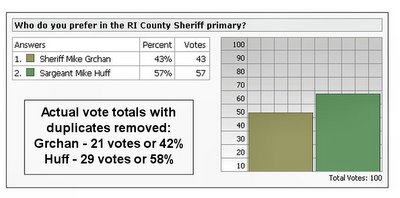National Popular Vote, an idea who's time has come?
A coalition of organizations and former politicians are mounting a serious effort to enact a national popular vote, and they are focusing exclusively on Illinois as an obvious place to start their efforts.
Their advisory committee includes a bipartisan group of former politicians including former independent presidential candidate and former Republican congressman John Anderson of Illinois, former senator Birch Bayh (D-Indiana), former congressman John Buchanan (R-Alabama), fomer congresman Tom Campbell (R-California), former senator Dave Durenberger (R-Minnisota), and fomer senator and astronaut, Jake Garn (R-Utah).
Their website provides an FAQ and a wealth of information about this exciting proposal to shed the antiquated and largely useless electoral college system and instead elect our presidents by popular vote.
In addition, they've written a very interesting book, "Every Vote Equal: A State-based Plan for Electing the President by Popular Vote" which you can read on-line or download for free.
A national popular vote is an intriguing idea and there are interesting arguments both pro and con. One argument against it is that it would cause candidates to focus exclusively on the large population states and ignore the smaller or primarily rural states. However, the electoral system now skews the system even worse by forcing candidates to utterly ignore states which aren't swing states or in contention.
This is one of the reasons they're focusing the effort to implement this system on Illinois first.
As the issue is described on their site:
SHORT EXPLANATION OF THE PROPOSEDAs Sen. Bayh states,
"Agreement Among the States to Elect the President by National Popular Vote"
THE CURRENT SYSTEM
Under the current system of allocating electoral votes in presidential elections (used by 48 states and the District of Columbia), all of a state’s electoral votes are awarded to the candidate receiving the most popular votes within each state. But this system was not established by the Constitution, the Founding Fathers, or federal law. Instead, the allocation of electoral votes is exclusively a matter of state law. In fact, Maine and Nebraska currently award some of their electoral votes by congressional district as an example of this flexibility.
PROBLEMS WITH THE CURRENT SYSTEM
The current system forces presidential candidates to focus their campaigns on a handful of closely divided “battleground” states, thereby making the voters in two-thirds of the states irrelevant. The presidentially non-competitive states include six of the nation’s 10 largest states (California, Texas, New York, Illinois, New Jersey, and North Carolina), 12 of the 13 least populous states, and most of the medium-sized states.
Voter turnout is adversely affected in presidentially non-competitive states because voters realize that their votes do not matter. The number of non-competitive states has been increasing in recent decades.
Because the statewide winner-take-all system divides the national pool of 122,000,000 popular votes into 51 smaller pools, it regularly manufactures artificial crises even when the nationwide popular vote is not particularly close. In the past 60 years, there have been six presidential elections in which a shift of a relatively small number of votes in one or two states would have elected a presidential candidate who did not receive the most popular votes nationwide.
THE PROPOSED SOLUTION
Nationwide popular election of the President is the only approach that makes all states competitive in presidential elections and that makes every vote count equally.
For over 50 years, the public has supported nationwide popular election of the President by majorities of 70% or greater.
A federal constitutional amendment (requiring two-thirds of Congress and 38 states) is not required to change the state laws that currently specify use of the winner-take-all rule. Nationwide popular election of the President can be implemented if the states join together to pass identical state laws awarding all of their electoral votes to the presidential candidate receiving the most popular votes in all 50 states and the District of Columbia. The proposed state legislation would only come into effect only when it has been enacted, in identical form, by enough states to elect a President—that is, by states possessing a majority (270) of the 538 electoral votes.
The U.S. Constitution establishes a legal vehicle for the proposed coordinated state action, namely the "interstate compact." Examples of existing interstate compacts include the Colorado River Compact (which divides water among seven western states) and the Port Authority of New York and New Jersey (a two-state compact). Interstate compacts are enacted by states in the same way they enact ordinary legislation. It is settled constitutional law an interstate compact is legally enforceable contractual obligation among the states belonging to the compact and all of their officials.
"The President and Vice President should be chosen by the same method every other elective office in this country is filled—by citizen voters of the United States in a system which counts each vote equally. ...I unequivocally support this new strategy to provide for the direct election of the President and Vice President.Check out their site and find out more about this exciting proposal and then give us your opinion.
This new approach is consistent with the Constitution...It’s refreshing to know states have the ability under the Constitution to step up and create the sensible solution Americans have long been supporting."






















